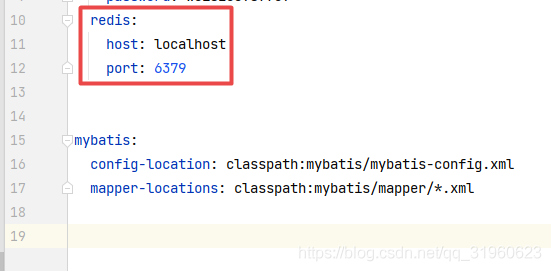如何在SpringBoot中使用RedisUtils工具类?针对这个问题,这篇文章详细介绍了相对应的分析和解答,希望可以帮助更多想解决这个问题的小伙伴找到更简单易行的方法。springBoot整合Redis引入Redis依赖 &l
如何在SpringBoot中使用RedisUtils工具类?针对这个问题,这篇文章详细介绍了相对应的分析和解答,希望可以帮助更多想解决这个问题的小伙伴找到更简单易行的方法。
引入Redis依赖
<!-- redis--><dependency> <groupId>org.springframework.boot</groupId> <artifactId>spring-boot-starter-data-redis</artifactId></dependency>设置Redis的Template

RedisConfig.java
package cn.wideth.config;import org.springframework.context.annotation.Bean;import org.springframework.context.annotation.Configuration;import org.springframework.data.redis.connection.RedisConnectionFactory;import org.springframework.data.redis.core.RedisTemplate;import org.springframework.data.redis.serializer.RedisSerializer;@Configurationpublic class RedisConfig { @Bean public RedisTemplate<String, Object> redisTemplate(RedisConnectionFactory factory) { RedisTemplate<String, Object> template = new RedisTemplate<>(); template.setConnectionFactory(factory); // 设置key的序列化方式 template.seTKEySerializer(RedisSerializer.string()); // 设置value的序列化方式 template.setValueSerializer(RedisSerializer.JSON()); // 设置hash的key的序列化方式 template.setHashKeySerializer(RedisSerializer.string()); // 设置hash的value的序列化方式 template.setHashValueSerializer(RedisSerializer.json()); template.afterPropertiesSet(); return template; }}设置Redis连接信息

Redis工具类
redisTemplate API
opsForValue -> String
opsForSet -> Set
opsForHash -> hash
opsForZset -> SortSet
opsForList -> list队列
package cn.wideth.util.other;import org.springframework.beans.factory.annotation.Autowired;import org.springframework.data.redis.core.*;import java.util.List;import java.util.Set;import java.util.concurrent.TimeUnit;public class RedisUtils { @Autowired private RedisTemplate<String, Object> redisTemplate; private static double size = Math.pow(2, 32); public boolean setBit(String key, long offset, boolean isshow) { boolean result = false; try { ValueOperations<String, Object> operations = redisTemplate.opsForValue(); operations.setBit(key, offset, isShow); result = true; } catch (Exception e) { e.printStackTrace(); } return result; } public boolean getBit(String key, long offset) { boolean result = false; try { ValueOperations<String, Object> operations = redisTemplate.opsForValue(); result = operations.getBit(key, offset); } catch (Exception e) { e.printStackTrace(); } return result; } public boolean set(final String key, Object value) { boolean result = false; try { ValueOperations<String, Object> operations = redisTemplate.opsForValue(); operations.set(key, value); result = true; } catch (Exception e) { e.printStackTrace(); } return result; } public boolean set(final String key, Object value, Long expireTime) { boolean result = false; try { ValueOperations<String, Object> operations = redisTemplate.opsForValue(); operations.set(key, value); redisTemplate.expire(key, expireTime, TimeUnit.SECONDS); result = true; } catch (Exception e) { e.printStackTrace(); } return result; } public void remove(final String... keys) { for (String key : keys) { remove(key); } } public void remove(final String key) { if (exists(key)) { redisTemplate.delete(key); } } public boolean exists(final String key) { return redisTemplate.hasKey(key); } public Object get(final String key) { Object result = null; ValueOperations<String, Object> operations = redisTemplate.opsForValue(); result = operations.get(key); return result; } public void hmSet(String key, Object hashKey, Object value) { HashOperations<String, Object, Object> hash = redisTemplate.opsForHash(); hash.put(key, hashKey, value); } public Object hmGet(String key, Object hashKey) { HashOperations<String, Object, Object> hash = redisTemplate.opsForHash(); return hash.get(key, hashKey); } public void lPush(String k, Object v) { ListOperations<String, Object> list = redisTemplate.opsForList(); list.rightPush(k, v); } public List<Object> lRange(String k, long l, long l1) { ListOperations<String, Object> list = redisTemplate.opsForList(); return list.range(k, l, l1); } public void add(String key, Object value) { SetOperations<String, Object> set = redisTemplate.opsForSet(); set.add(key, value); } public Set<Object> setMembers(String key) { SetOperations<String, Object> set = redisTemplate.opsForSet(); return set.members(key); } public void zAdd(String key, Object value, double scoure) { ZSetOperations<String, Object> zset = redisTemplate.opsForZSet(); zset.add(key, value, scoure); } public Set<Object> rangeByScore(String key, double scoure, double scoure1) { ZSetOperations<String, Object> zset = redisTemplate.opsForZSet(); redisTemplate.opsForValue(); return zset.rangeByScore(key, scoure, scoure1); } //第一次加载的时候将数据加载到redis中 public void saveDataToRedis(String name) { double index = Math.abs(name.hashCode() % size); long indexLong = new Double(index).longValue(); boolean availableUsers = setBit("availableUsers", indexLong, true); } //第一次加载的时候将数据加载到redis中 public boolean getDataToRedis(String name) { double index = Math.abs(name.hashCode() % size); long indexLong = new Double(index).longValue(); return getBit("availableUsers", indexLong); } public Long zRank(String key, Object value) { ZSetOperations<String, Object> zset = redisTemplate.opsForZSet(); return zset.rank(key,value); } public Set<ZSetOperations.TypedTuple<Object>> zRankWithScore(String key, long start,long end) { ZSetOperations<String, Object> zset = redisTemplate.opsForZSet(); Set<ZSetOperations.TypedTuple<Object>> ret = zset.rangeWithScores(key,start,end); return ret; } public Double zSetScore(String key, Object value) { ZSetOperations<String, Object> zset = redisTemplate.opsForZSet(); return zset.score(key,value); } public void incrementScore(String key, Object value, double scoure) { ZSetOperations<String, Object> zset = redisTemplate.opsForZSet(); zset.incrementScore(key, value, scoure); } public Set<ZSetOperations.TypedTuple<Object>> reverseZRankWithScore(String key, long start,long end) { ZSetOperations<String, Object> zset = redisTemplate.opsForZSet(); Set<ZSetOperations.TypedTuple<Object>> ret = zset.reverseRangeByScoreWithScores(key,start,end); return ret; } public Set<ZSetOperations.TypedTuple<Object>> reverseZRankWithRank(String key, long start, long end) { ZSetOperations<String, Object> zset = redisTemplate.opsForZSet(); Set<ZSetOperations.TypedTuple<Object>> ret = zset.reverseRangeWithScores(key, start, end); return ret; } }springboot一种全新的编程规范,其设计目的是用来简化新Spring应用的初始搭建以及开发过程,SpringBoot也是一个服务于框架的框架,服务范围是简化配置文件。
关于如何在Springboot中使用RedisUtils工具类问题的解答就分享到这里了,希望以上内容可以对大家有一定的帮助,如果你还有很多疑惑没有解开,可以关注编程网精选频道了解更多相关知识。
--结束END--
本文标题: 如何在Springboot中使用RedisUtils工具类
本文链接: https://www.lsjlt.com/news/276844.html(转载时请注明来源链接)
有问题或投稿请发送至: 邮箱/279061341@qq.com QQ/279061341
下载Word文档到电脑,方便收藏和打印~
2024-05-14
2024-05-14
2024-05-14
2024-05-14
2024-05-14
2024-05-14
2024-05-14
2024-05-14
2024-05-14
2024-05-14
回答
回答
回答
回答
回答
回答
回答
回答
回答
回答
0